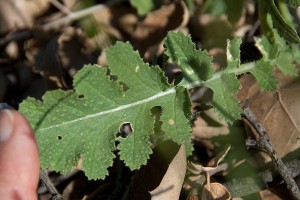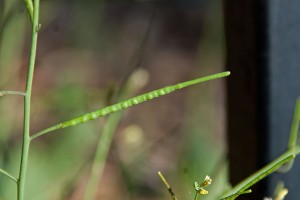Update: On March 11, the valiant BFS Volunteers removed every known Sahara Mustard plant on the BFS. Way to go, Volunteers!
The very nasty Sahara Mustard (Brassica tournefortii) has just appeared at the BFS in two small infestations along Foothill Blvd. near the BFS entrance and the near College Avenue.
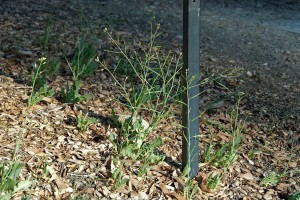
The nerve! A Sahara Mustard plant growing right next to our Bernard Field Station sign. ©Nancy Hamlett.
The Sahara Mustard, a native of semi-arid and arid deserts of North Africa and the Middle East, as well as Mediterranean lands of southern Europe, probably arrived in California with date palms from the Middle East. It was first collected in North America in 1927 in the Coachella Valley, and that specimen, which was part of the Pomona College Herbarium, is now housed at the Rancho Santa Ana Botanic Garden Herbarium (POM147846). Sahara Mustard has only become prominent in Los Angeles County in the last decade.
Sahara Mustard plants are 4 to 40 inches tall and generally have an open bushy appearance, although the form is quite variable. The basal leaves are are long, with pairs of deep toothed lobes, and are covered with stiff hairs.
Sahara Mustard plants flower early – the ones at the BFS are blooming and have already formed fruits. The flowers are small (petals less than one-quarter inch) and dull yellow, making them less conspicuous than our other exotic mustards. The fruits diverge stiffly from the stem at a forty-five degree angle. They are born on a half-inch pedicel (stalk) and have an obvious beak at the tip.
Sahara Mustard is very prolific – large plants produce up to 16,000 seeds. Dried plants can break off at the base and tumble like tumbleweed, spreading seeds rapidly across the landscape. When wet, a sticky gel forms over the seed case enabling seeds to disperse long distances by adhering to animals and probably automobiles. It often first appears along roadways as it has at the BFS.
Because Sahara Mustard seeds germinate early and the plants grow rapidly, they out-compete native plants for soil moisture and light, and they produce seeds before many native species have even begun to flower. In the winter-spring of 2005 about three-quarters of the most famous wildflower areas in California and Arizona were overrun with Saharan Mustard.
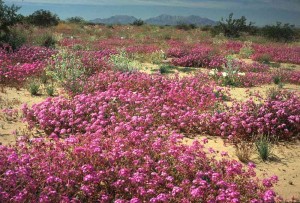
A photo taken in 1998 of wildflowers in the northern end of the Mohawk Dunes in western Arizona. ©Mark Dimmett, Arizona-Sonora Desert Museum.
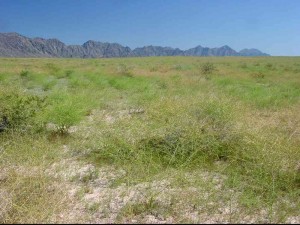
The same area photographed in 2005 when Sahara Mustard covered 70-90% of the surface area, and almost no native wildflowers bloomed. ©Mark Dimmett, Arizona-Sonora Desert Museum.
As if that weren’t enough, Sahara Mustard increases fuel loads and fire hazard in coastal sage scrub, and its high oxalic acid content may be toxic to native herbivores.
The BFS Volunteers are planning to eradicate this nasty mustard from the field station. If you would like to help, please contact Nancy Hamlett, BFS Volunteer Coordinator, at nancy_hamlett@hmc.edu or 909-607-3811.
Sources and further information:
- Sahara Mustard – from the California Invasive Plant Council.
- Sahara mustard (Brassica tournefortii) – from the Arizona-Sonora Desert Museum.
